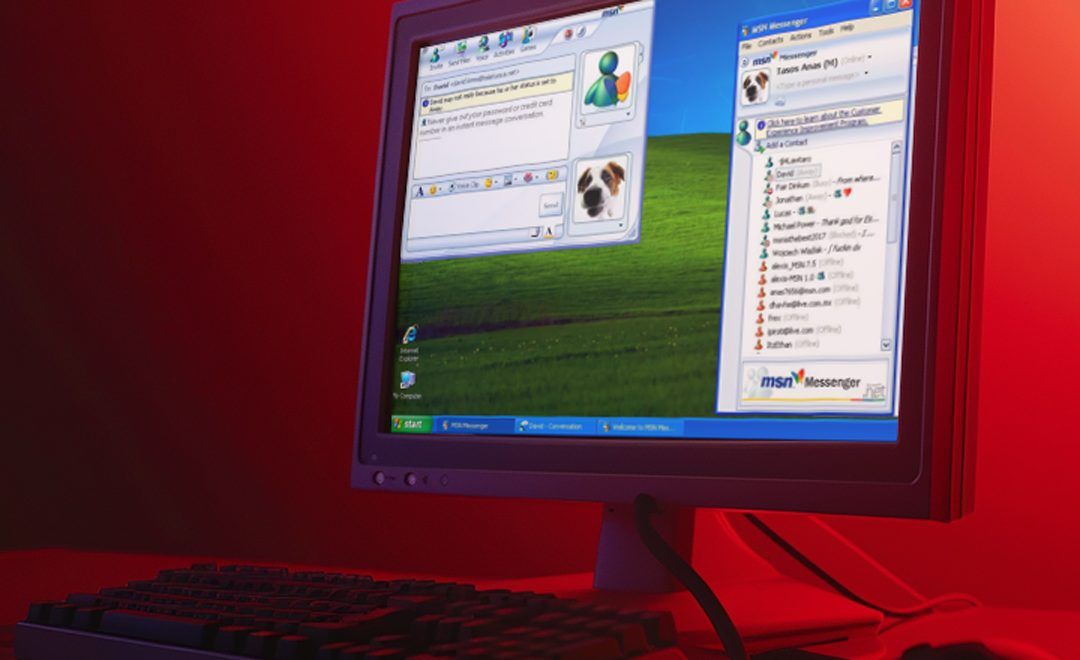Before the current instant messaging apps were installed on our mobile phones to occupy much of our time (something like 12 or 13 hours a day) there were already some programs used to catch up with our aunt from Cuenca or to know what our brother-in-law Pepe had for breakfast.
Of all of them, without a doubt, the most successful was Msn Messenger. The program, developed by Microsoft, took place on the desktops of millions of computers during the first decade of this century, enabling trillions of more or less transcendent conversations.
In October 2014 Msn Messenger ceased to be operational, leaving behind countless stories, including their own. Let’s get to know it a little better.
What happened with msn Messenger? Birth and Boom
Msn Messenger was born on July 22, 1999, anticipating for only a few months events such as Y2K or the End of the World.
Msn Messenger was Microsoft’s response to the dominance in instant messaging that AIM (America-OnLine Instant Messenger) had at that time, launched a couple of years earlier by AOL, one of the pioneers and first dominators in commercial telephony and Internet services.
Back then; Microsoft was clear about the boom of this type of programs, and the need to integrate it into Windows in a natural way. How did they do that? It’s not too difficult if you have ‘on payroll’ the most used operating system and one of the most registered email services in the world, Hotmail.
Thus, integrated in Windows (standard in Windows XP, although it already had optional installation in Windows ME)) and Hotmail (it offered the possibility of using the same username and password in Msn Messenger as the one used in Hotmail) the explosion of the messaging program was instantaneous.
In addition to all these advantages, the development of the different versions of Msn Messenger (which also had other names, such as Windows Messenger or Windows Live Messenger) was very dynamic, which allowed it to have a large number of fans over more than a decade.
Msn Messenger was part of the Internet gateway in many homes around the world. Before long, its classic buzz, emoticons and some very useful features, such as file transfer, became tremendously popular, making it a tool that any PC user would frequently use.
And not only that. For many people, Msn Messenger was the first way to establish communications today as frequent as video calls, which led to its biggest boom in 2009, with no less than 330 million active users worldwide. However, at that time some very dark clouds were beginning to appear on its horizon; so dark that Msn Messenger could not survive the storm that was approaching…
A hard and fast fall
What happened with msn Messenger? Msn Messenger had to face two rivals of colossal dimensions, which would not only mean the end of its life, but would even change the social panorama of the time. You know what I’m talking about because you live with them every day: the smartphone and social networks.
The smartphone damaged traditional instant messaging programs through a barrage of new offers, the popular apps, which came to provide thousands of alternatives to Msn Messenger. As you know, a few months after smartphones became popular, Whaptsapp took over the throne of messaging apps, taking millions of users away from traditional programs.
On the other hand, social networks were made for the leisure time of millions of users, representing another very strong way of competition for Msn Messenger. Spreading like wildfire and having some of them (especially Facebook) internal chat, would promote a new way of communicating that is still very much in force today.
What happened with msn Messenger? Msn Messenger was not able to survive so many changes and lost users quickly, until Microsoft decided to replace it with Skype, announcing its final closure on October 31, 2014 (it’s time for Msn Messenger fans to cry).
The rise and fall of Msn Messenger is one of the symbols of the rapid evolution of the Internet, and of how some tremendously successful phenomena can be thrown into stardom in just a few months and then fall at the same speed. Although it is important to remember that it is not always the same; some services, such as e-mail, still survive after decades!
Okay, now that we know what happened with Msn Messenger, we can move on to more current topics.
How about talking about Pandora FMS? In the years when Msn Messenger dominated the Universe, Pandora FMS was already coming out of its little shell to become the flexible monitoring software it is today. Software capable of monitoring devices, infrastructures, applications, services and business processes.
Do you want to know better what Pandora FMS can offer you? Great then. Click here: https://pandorafms.com/
Or you can also send us any query you may have about Pandora FMS. You can do it in a very simple way, thanks to the contact form that can be found at the following address: https://pandorafms.com/contact/
The team behind Pandora FMS will be delighted to assist you!

Dimas P.L., de la lejana y exótica Vega Baja, CasiMurcia, periodista, redactor, taumaturgo del contenido y campeón de espantar palomas en los parques. Actualmente resido en Madrid donde trabajo como paladín de la comunicación en Pandora FMS y periodista freelance cultural en cualquier medio que se ofrezca. También me vuelvo loco escribiendo y recitando por los círculos poéticos más profundos y oscuros de la ciudad.
Dimas P.L., from the distant and exotic Vega Baja, CasiMurcia, journalist, editor, thaumaturgist of content and champion of scaring pigeons in parks. I currently live in Madrid where I work as a communication champion in Pandora FMS and as a freelance cultural journalist in any media offered. I also go crazy writing and reciting in the deepest and darkest poetic circles of the city.

















